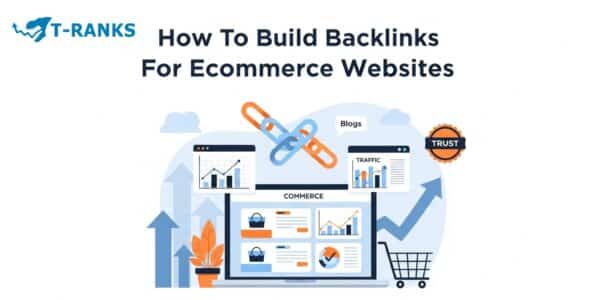Why do some online stores dominate Google while others, even with great products, barely get seen? The difference often comes down to one powerful factor: backlinks.
Backlinks for ecommerce are more than just a ranking signal. They are a trust signal. But building them is harder than it looks. Unlike blogs or service sites, ecommerce stores face unique SEO challenges such as thin product pages, limited linkable content, and fierce marketplace competition.
That’s where smart, scalable ecommerce link building comes in.
This guide walks you through proven, real-world link building strategies for ecommerce. You’ll learn how to earn backlinks through guest post hybrids, HARO outreach, unlinked brand mentions, product roundups, visual content, and more. These strategies help you earn backlinks that improve search visibility and increase conversions.
We’ll also show how ecommerce SEO benefits when you focus on high-impact pages,starting with fixing broken backlinks and reclaiming lost link equity.
Whether you’re selling fashion, fitness, or gadgets, this guide gives you the link building roadmap to grow sales and search authority.
Why Backlinks Are Essential for Ecommerce SEO
Backlinks are a key ranking factor for ecommerce SEO because they signal trust, build authority, and drive qualified traffic to your product and category pages.
When a trusted site links to your store, it acts as a vote of confidence,telling search engines that your content is valuable. This can help your product pages rank higher in search results, especially for competitive, high-intent keywords.
Key Benefits of Ecommerce Backlinks:
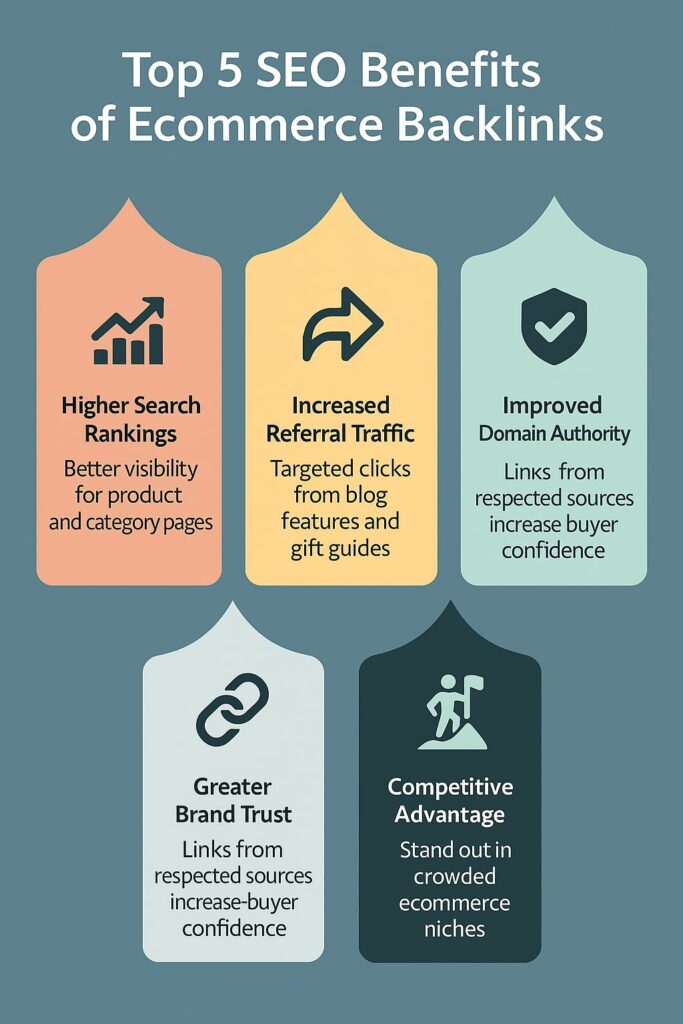
- Higher Search Rankings: Backlinks improve your visibility on Google, especially for transactional pages like category and product listings.
- Increased Referral Traffic: Links from blogs, gift guides, and directories send potential buyers directly to your site.
- Improved Domain Authority: A strong backlink profile boosts your site’s overall credibility and indexing speed.
- Greater Brand Trust: Links from reputable sources build consumer confidence, especially in crowded markets.
- Competitive Advantage: Backlinks give your store an edge over rivals who rely only on on-page SEO.
Why Ecommerce Sites Struggle to Earn Links:
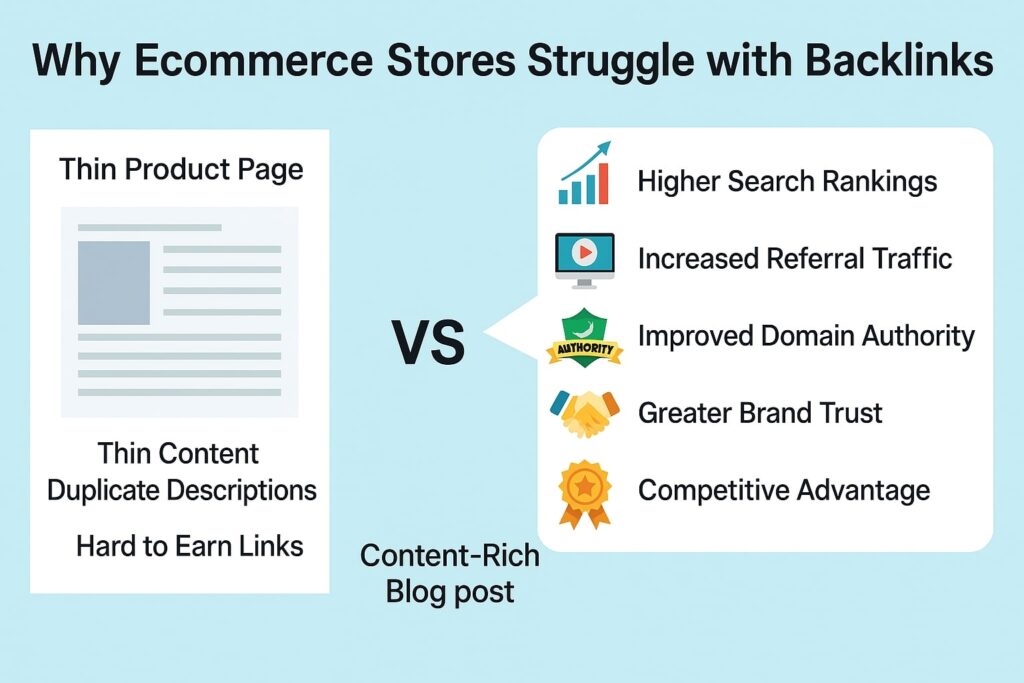
Unlike blogs or service websites, ecommerce pages face structural challenges that make link building harder:
- Thin or duplicate product descriptions
- Short content length and limited editorial value
- Out-of-stock and seasonal product issues
- SERPs dominated by large marketplaces like Amazon and Walmart
That’s why ecommerce link building requires a strategic approach—focused on content formats, link placement, and outreach methods that suit commercial pages.
Google’s Perspective on Ecommerce Backlinks
Google doesn’t treat all backlinks equally. For ecommerce, context and placement matter:
- Homepage backlinks help spread link equity sitewide but don’t improve specific product rankings.
- Category page backlinks support broader commercial keywords like “best running shoes” or “affordable skincare.”
- Product page backlinks carry high conversion potential but require more effort to earn naturally.
Google also weighs backlinks in terms of E-E-A-T (Experience, Expertise, Authoritativeness, Trustworthiness). Editorial links from niche blogs, review sites, or media outlets signal that your brand is reputable and safe for users.
To rank and convert in ecommerce, your backlink strategy must focus on:
- Relevance (link source matches your niche),
- Context (link placement makes editorial sense),
- Quality (links come from trusted, non-spammy domains).
7+ Advanced Backlink Strategies for Ecommerce Success
If you want to rank beyond page two, you need more than basic backlinks. Generic link building won’t cut it in competitive ecommerce niches. What you need are advanced strategies that target product pages, boost topical authority, and drive real results.
In this section, we’ll explore high-impact ecommerce link building tactics. For example unlinked brand mentions, guest post hybrids, expert roundups, and buying guides. These link building technoques help online stores earn to trusted and contextual backlinks.
These are the same strategies used by fast-growing brands to climb rankings, increase traffic, and generate consistent sales. Let’s explore all cateogries one by one.
1.Get Featured on “Where to Buy” & Niche Directories
Want fast, high-authority backlinks with buyer intent? “Where to Buy” pages and curated niche directories are often overlooked, yet highly effective sources of contextual backlinks for ecommerce.
1. Manufacturer “Where to Buy” Pages
If you’re an authorized reseller or retail partner, request a listing on your supplier’s “Find a Reseller” or “Where to Buy” page. These backlinks are trusted by Google and typically live on domains with strong authority.
For example, take a look at the screenshot below from Yubico’s Reseller page, where verified partners are listed by region.
The second screenshot shows the actual list of approved sellers, each with a direct link to their website. These are valuable backlinks because they come from recognized brand domains and help users land directly on your site—boosting trust signals and supporting E-E-A-T.
2. Niche Directories & Product Roundups
Editorial product lists and buyer guides are another great way to earn backlinks. They usually include a short description of your brand and a dofollow link—often placed in evergreen content with ongoing SEO value.
One great example is Modern Dog Magazine’s Puppy Essentials Guide, which showcases dog products with external links. In the screenshot, you can clearly see a dofollow link pointing to furbo.com . This kind of link not only sends referral traffic but also strengthens your domain’s credibility.
Sample Outreach Email
Hi [First Name], I came across your [resource page / product guide] and really appreciate how it helps shoppers find quality brands. I run [Your Store], where we sell [Product Type], and would love to be considered for inclusion. Happy to send over product images, specs, or special offers if helpful for your readers. Thanks for your time! Best, [Your Name] [Your Store Name] | [URL]
2. Unlinked Brand Mentions: Turn Mentions into Links
Unlinked brand mentions occur when your brand name is referenced in online content but not hyperlinked to your website. These missed links can become high-quality backlinks—if you identify them and reach out strategically.
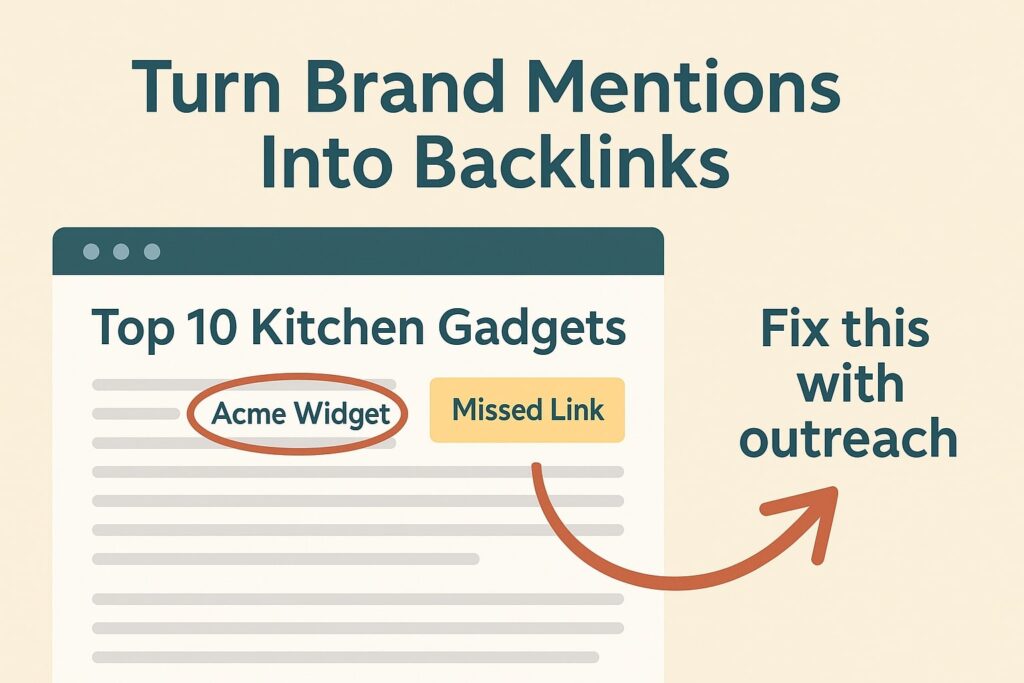
Use tools like Google Alerts, Brand24, Mention, or Ahrefs Content Explorer to monitor where your brand appears online without being linked. Focus on high-authority websites or niche blogs that are contextually relevant to your ecommerce niche.
Once identified, prioritize mentions based on:
- Relevance to your product or category
- Domain authority of the referring site
- Positioning within the article (e.g., product recommendation)
Then, contact the content creator with a short, personalized request. Instead of just asking for a link, explain how it enhances their content and benefits their readers.
For example, imagine your brand—like T-Ranks.com—is mentioned in an industry blog post but without a hyperlink. That’s a missed opportunity. Even though this isn’t an ecommerce example, the process remains the same. First, you identify unlinked brand mentions. Then, you reach out and ask for a backlink through polite and relevant communication.
Sample Outreach Email
Hi [Author Name], Thanks for mentioning [Your Brand] in your article “[Title].” We really appreciate it! Would you be open to linking our name to [https://yourbrand.com] so your readers can find us more easily? Let me know if I can provide any additional resources or images to help. Best regards, [Your Name] [Your Store Name]
This strategy works because:
- The publisher already trusts your brand enough to mention it.
- Editorial in-content links improve authority and SEO rankings.
- It’s a natural, white-hat way to grow backlinks with high contextual relevance.
Converting unlinked brand mentions into live links can significantly boost your SEO. Focus on mentions from high-quality sites for the best results. When approached with personalized and respectful outreach, these links help strengthen domain authority. They also support E-E-A-T signals and bring in qualified referral traffic. Best of all, this strategy works without needing to publish new content.
3. Guest Post + Product Review Hybrid Approach
This strategy combines two proven methods: writing guest posts and offering product reviews. When used together, they build backlinks, increase traffic, and create brand awareness—all in one campaign.
Here’s how it works:
First, find a blog or website in your niche that accepts guest contributions. Write a helpful article that fits their audience. Inside that article, you naturally include a mention or mini-review of your product.
You don’t need to hard-sell. Just explain what the product is, what it does, and why it matters in the context of the topic. Then, add a link to your product or store page.
For example, a travel accessories brand could write an article titled “5 Innovative Travel Gadgets You Didn’t Know You Needed” and include their own multi-tool as one of the featured items. This gives readers helpful information while earning the brand a contextual backlink to its product page.
This approach works best in niches like fashion, lifestyle, gadgets, home decor, and wellness—where audiences expect product recommendations.
Why this method works:
- It exposes your brand to a new, relevant audience.
- The backlink comes from editorial content, which is valued by Google.
- The product review adds credibility and encourages conversions.
- It builds authority and trust, especially when placed on a respected site.
Tips to get started:
- Find blogs in your niche that accept guest posts or reviews.
- Offer your product for free if needed to encourage honest inclusion.
- Focus on providing value in your article—not just promoting.
- Customize each pitch to the blog’s tone and audience.
This hybrid strategy is simple, scalable, and perfect for ecommerce brands trying to grow organically through content and relationships—not just ads.
4. Link-Worthy Content: Buying Guides, Comparisons & Statistics
If no one wants to link to your product pages, the solution is simple: create content that people do want to link to. This includes buying guides, product comparisons, and useful statistics.
These types of content are easy to understand, valuable for readers, and often used by other sites as references. That’s what makes them great for building backlinks.
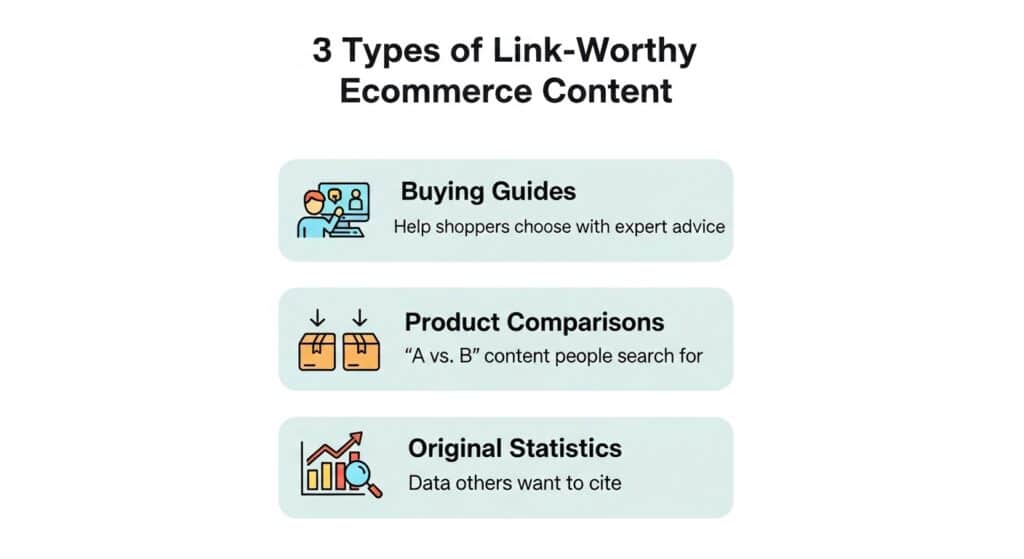
Buying Guides
A buying guide helps customers choose the right product.
Example: “How to Pick the Best Travel Backpack for 2025.”
You explain what to look for, show options, and link to your own product pages.
These guides are helpful for new customers—and bloggers often link to them when writing related content.
Product Comparisons
These are “vs” posts that compare two products side by side.
Example: “iRobot vs. Roborock: Which Vacuum Wins in 2025?”
You highlight pros, cons, and ideal use cases. Add links to your own store if you sell one of the options.
People search for these all the time—and other blogs often reference them.
Statistics and Trends
If you have access to any data—customer surveys, sales numbers, or product usage, you can publish it as a short blog post.
Example: “68% of customers prefer eco-friendly packaging.”
Even one stat like this can earn backlinks if others quote your data.
Use tools like Google Forms or post-purchase feedback to collect insights from your audience.
Why this content gets links:
- It solves real problems for shoppers.
- It’s helpful and easy to share.
- It supports SEO by targeting informational keywords.
- Other writers and websites often reference it.
Start with one strong guide or comparison. Promote it through outreach or social media. Over time, you’ll attract links that boost your authority—and support product page rankings too.
5. Leverage HARO, Digital PR & Product Roundups
Getting featured in online publications is one of the fastest ways to earn high-authority ecommerce backlinks. You don’t need a big PR budget—just a repeatable outreach strategy that positions your brand as helpful, not promotional.
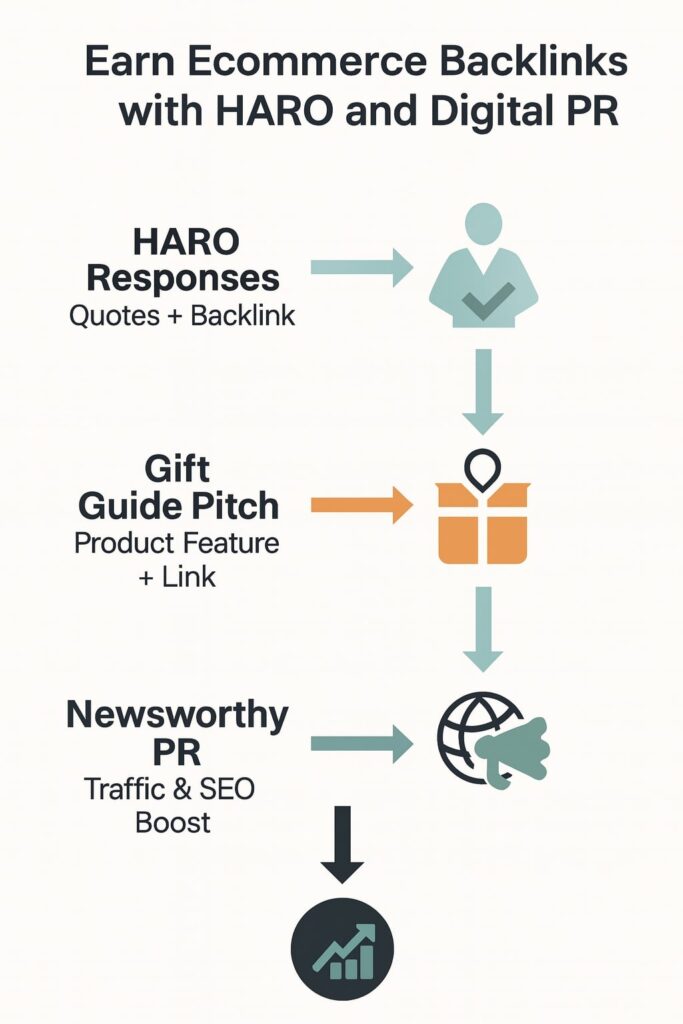
Here are three proven methods:
1. HARO: Help a Reporter Out
HARO connects journalists with sources. As an ecommerce brand, you can respond to media requests with expert insights, data, or product recommendations.
If accepted, your quote gets featured in an article—often alongside a backlink to your site. These links usually come from high Domain Authority (DA) websites and help build your E-E-A-T profile.
Example: A skincare brand recommends their serum in response to a HARO query on “winter skincare tips.” It’s published in a beauty blog, with a dofollow link to the product page.
➡️ Learn more: What Are HARO Backlinks and How Do They Work?
2. Roundup Posts and Gift Guides
Roundups are curated blog posts like:
- “Top 10 Kitchen Gadgets for 2025”
- “Best Eco-Friendly Gifts for Travelers”
These posts are highly linkable and usually rank for transactional keywords. Getting featured not only earns you a backlink but puts your product in front of a buying audience.
Send a short pitch with your product’s value, image, and a special offer if applicable.
Tip: Use search operators like:
“best [product] for [audience]” + “site:.com”
to find relevant blogs that already publish listicles and gift guides.
3. Digital PR Pitches
This involves crafting newsworthy angles—like viral trends, product launches, or survey results—and pitching them to journalists, bloggers, or lifestyle editors.
Strong pitches focus on story value, not just product features. A well-positioned PR hook can earn links from national publishers or niche authority blogs.
Example: A fitness brand publishes a mini report—“60% of Gen Zs Prefer At-Home Workouts”—and pitches it to wellness writers. They’re featured in three roundup-style posts with backlinks to their store.
Why this works:
- These placements bring trust signals from real publications.
- Links are contextual, not spammy.
- They drive qualified referral traffic and support product-page SEO.
Start small: reply to one HARO query daily and pitch 2–3 roundup or PR angles per week. Over time, these efforts compound into sustainable authority growth.
6. Recover Lost Links and Fix Broken Links
Recovering lost links and fixing broken links is a key part of link reclamation—the process of maintaining a healthy backlink profile and preserving SEO authority. Broken or outdated links can hurt your search rankings and frustrate users. This step ensures that the link equity you’ve earned doesn’t go to waste.
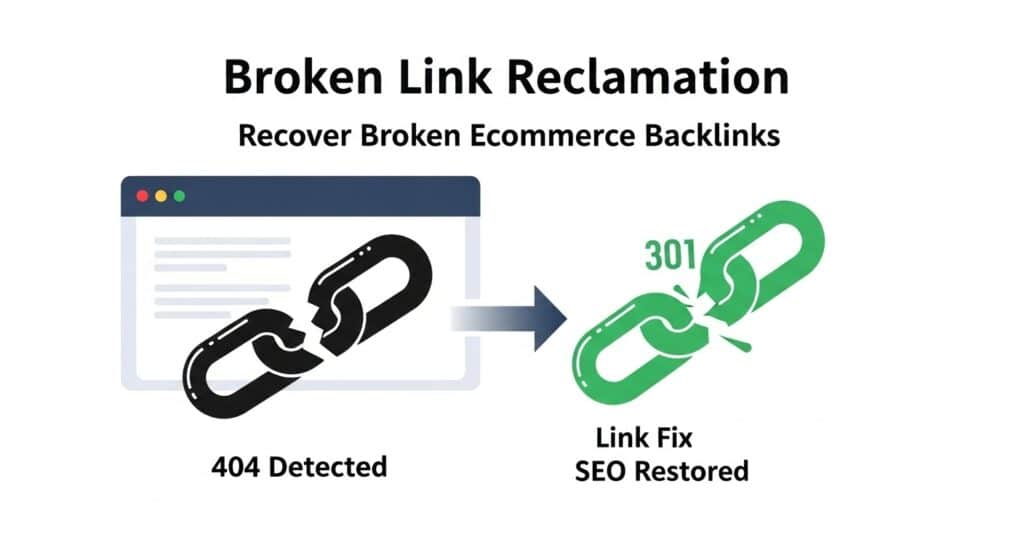
Step 1: Identify Lost and Broken Links
Use reliable tools to monitor your backlink profile:
- External Backlinks: Tools like Ahrefs, Semrush, or Google Search Console can show which backlinks are broken or lost.
- Internal Links: Scan your own site for internal links pointing to deleted or outdated URLs. Tools like Screaming Frog and Ahrefs Site Audit help here.
- GSC Coverage Report: Use the “Pages” section in GSC to identify crawl issues caused by broken internal links or deleted pages.
These tools help detect whether the page is gone, the link has changed, or the referring site updated content.
Step 2: Fix and Redirect Broken Pages
Once you’ve identified broken links, take one of the following actions:
- Update the Link: If content has moved, update internal or external links to the new destination.
- 301 Redirect: Redirect the old URL to a new, relevant page on your site. This preserves link equity.
- Remove the Link: If no replacement exists, it’s better to remove the broken reference than leave a dead link.
- Replace with Fresh Content: If another page serves the same intent, suggest that to the referring site.
You can find a full walkthrough in our broken backlinks repair guide.
Step 3: Reclaim Lost Links via Outreach
When a site removes or drops a backlink, reach out to them with a polite request to restore or update the link. This works well if the referring page still exists, but the link was removed during a redesign or content update.
Sample Outreach Approach
Hi [Name], I noticed that a link from your article on [topic] to our page is no longer working. We’ve updated the content here: [new URL]. If it’s still a good fit for your readers, we’d love to be relinked.
Use Ahrefs’ “Lost Backlinks” report or Semrush’s “Backlink Audit” tool to track these links.
Step 4: Broken Link Building (BLB)
This is a proactive tactic. You find broken outbound links on niche-relevant sites and pitch your own content as a replacement.
How to do it:
- Use tools like Ahrefs Content Explorer, Broken Link Checker, or Check My Links Chrome extension.
- Filter by blogs or resources in your industry.
- Reach out and offer a working, relevant resource from your own site.
It helps other site owners clean up dead links—while you earn high-context editorial backlinks.
Why Link Reclamation Matters:
- Protects SEO value from backlinks you’ve already earned.
- Improves crawlability and user flow by cleaning up internal link errors.
- Boosts trust signals, especially when lost links are recovered from high-authority domains.
Make link reclamation a routine task in your backlink management workflow. A simple monthly audit can restore lost SEO power and help you capture new backlink opportunities.
7. Infographics, Visual Assets & Skyscraper Refreshes
Creating visual assets—like infographics and product comparisons—is a powerful way to attract natural backlinks from editorial sites, review blogs, and resource pages.
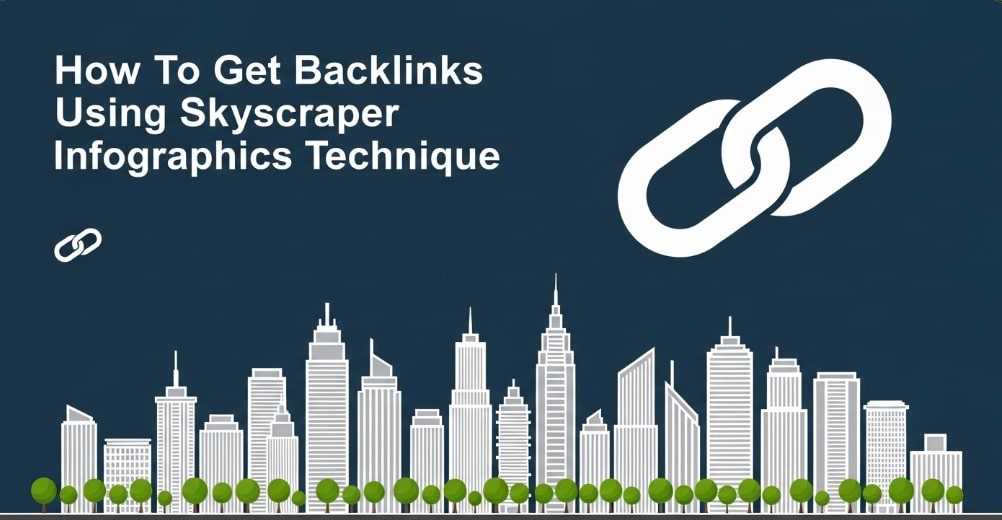
Why it works:
Visuals simplify information. They’re easy to embed, add value to other blogs, and often earn passive backlinks over time.
Let’s say you run a travel gear store. You could create an infographic titled “How to Pack Light for a 7-Day Trip”. A travel blog might embed it in their packing guide, linking back to your site as the source.
Real-World Example:
Sleepopolis created a mattress comparison chart that visually ranks different mattress brands across several metrics. As a result, several wellness blogs and shopping guides embedded the graphic and linked back to the source—turning a simple visual into a long-term backlink asset.
You can replicate this strategy with:
- Product comparisons: Show specs side-by-side with clear visuals.
- Buying guides: Turn your blog into a skimmable decision tool.
- Survey data: Use original statistics or user reviews to build charts.
Free tools to try:
- Canva – user-friendly drag-and-drop design.
- Piktochart – good for charts and educational layouts.
- Visme – best for interactive or business-style visuals.
Bonus: Refresh & Reclaim With the Skyscraper Method
The Skyscraper Technique helps you replace outdated content that still earns backlinks—by publishing something better.
How it works:
- Use tools like Ahrefs or Semrush to find popular pages in your niche with lots of referring domains.
- Analyze the gaps: Is it outdated? Lacking visuals? Missing product updates?
- Create an updated, deeper version. Include expert insights, modern visuals, and improved structure.
- Reach out to the referring domains and suggest your guide as an updated replacement.
Example Use Case:
You discover a blog post from 2020 titled “Top Eco-Friendly Backpacks.” It still gets traffic and backlinks. You build a better version with 2025 models, visual comparison charts, and availability links. Then contact the same referring sites offering your post as the new resource.
For step-by-step execution of this method, check out our guide on how to find competitor backlinks and apply them to your refresh outreach.
Also, learn how to analyze backlinks to prioritize which ones are worth reclaiming during your outreach.
Industry-Specific Link Building for Ecommerce Niches
Not all ecommerce niches benefit from the same link building tactics—each industry demands a tailored strategy to attract relevant backlinks that convert. Whether you’re selling fitness gear, pet products, electronics, or SaaS subscriptions, the type of content you create and the publishers you target will vary.
In this section, we’ll break down proven backlink acquisition approaches tailored to five high-impact verticals:
- Fashion and lifestyle
- Tech and gadgets
- Fitness and wellness
- Pet supplies
- SaaS and digital product stores
1. Product-Focused Link Tactics for Fashion and Lifestyle
Fashion and lifestyle ecommerce brands can earn high-quality backlinks by focusing on visual storytelling, blogger collaborations, and content placements in curated guides. These strategies help you get mentioned on relevant blogs, lookbooks, and gift roundups—right where your ideal shoppers spend their time.
Here’s how to do it:
- Collaborate with fashion bloggers and micro-influencers
Reach out to small fashion bloggers for “Outfit of the Day” (OOTD) features or product roundups. Many of them link to the product pages they mention—especially if you offer something new or ethically made. - Submit to seasonal gift guides and editorial lookbooks
Products like scarves, tote bags, and accessories fit naturally into seasonal style guides. These guides often include dofollow backlinks and help drive qualified traffic.
Real-world example:
Sustainable Jungle, a leading eco-conscious blog, included Zestt Organics in its article “5 Sustainable Scarves You Can Responsibly Wrap Up In”. The blog linked directly to the brand’s website and featured their product as part of an ethical gift guide.
(See screenshot below for proof of backlink inclusion)
- Use affiliate platforms to encourage product mentions
Sign up on ShopStyle Collective or LTK (LikeToKnow.it) to offer small commissions to bloggers and stylists. This makes your products more likely to be featured on monetized content platforms. - Build UGC galleries
Collect customer Instagram posts wearing or using your products. Turn them into a lookbook or gallery on your site that fashion roundups and trend bloggers can reference.
These strategies generate natural backlinks while also building trust, brand awareness, and social proof—key factors in fashion ecommerce success.
2. Data-Driven Backlinks for Tech & Gadgets Ecommerce
If you sell tech products online, you can build strong backlinks by creating useful, data-based content. People shopping for gadgets often want detailed comparisons, honest benchmarks, and clear specs. When you provide this information, other websites are more likely to link to you as a helpful resource.
Here are four easy ways to earn backlinks in the tech niche:
- Make product comparison tables
Shoppers love to compare products. Create simple tables that highlight key specs like battery life, speed, price, or features. This kind of content is often linked in blog posts and review articles. - Do real product testing or benchmarks
If you sell headphones, smartwatches, or chargers, run tests and share the results. For example, test battery life or charging time and publish the numbers. These data points help people decide—and they get shared on blogs and forums. - Get featured in “Best of” gadget lists
Many tech blogs create “Top 5” or “Best Budget Picks” articles. Reach out to them with your product info and offer reasons why your item belongs in their list.
Real example:
The tech review site RTINGS published a guide called “7 Best True Wireless Earbuds.” The post included detailed test results and easy-to-read charts. Because the content was so valuable, it earned 125 backlinks from 46 different websites—as proven in the screenshot below. This happened naturally because people trust and share well-organized comparison content.
- Join Reddit and tech forums
Share helpful data or comparisons in relevant communities like r/Headphones or r/Tech. When you post non-promotional, useful content, users often link to your site as the source.
Why This Strategy Works
- People trust content that includes data and specs.
- Comparison charts are easy to share and link to.
- Forums and roundup posts can bring consistent referral traffic.
- It positions your store as credible—not just promotional.
By offering real value through numbers, tests, and visual tools, you make your content link-worthy. These backlinks help you improve your rankings, reach new customers, and grow your brand.
3. Local Product Businesses: Use Events & Sponsorships
Running a local ecommerce brand? Whether you sell handmade goods, fitness gear, or pet supplies, events and sponsorships are a smart way to earn relevant, high-quality backlinks. These links improve your SEO and help you reach nearby customers.
Here’s how to build backlinks through local outreach:
- Sponsor local events or charities
Events like school fundraisers, charity walks, or community fairs often list their sponsors on .org or .edu websites—with a link to the sponsor’s site. These backlinks are typically high-authority and hyper-relevant. - Get listed in local directories
Submit your business to city-specific directories, chamber of commerce listings, or retail hubs like Shop Local [City] guides. These sites help Google understand your location and relevance—boosting local visibility. - Offer student discounts or scholarships
Reach out to local universities and offer a small scholarship, student discount, or giveaway. In return, many schools list supporting businesses on .edu pages, which often come with a backlink. - Pitch to local news or blogs
Local lifestyle sites and bloggers frequently feature community businesses—especially if you’re involved in an event or launch. A simple story pitch can result in a backlink from a well-trafficked local publication.
Example:
A Toronto-based ecommerce brand selling eco-friendly fitness gear sponsored a community yoga event. They were listed as a supporter on the event’s .org site and featured in a “Local Wellness Businesses to Know” article on a city lifestyle blog—both with backlinks to their store.
Why Local Link Building Works
- .org and .edu links carry strong authority and local trust.
- Directory listings improve local search rankings.
- Community involvement builds brand awareness and credibility.
- Media mentions drive referral traffic from nearby buyers.
Even a few local backlinks can boost your store’s visibility for region-based keywords—especially when combined with a Google Business Profile.
Why Choose T-RANKS for Ecommerce Link Building?
We help ecommerce sites earn powerful backlinks that drive rankings and sales—without spam or shortcuts.
Manual Outreach Only
We secure contextual links through real relationships, not automation tools.
Niche Relevance First
All backlinks come from sites directly relevant to your product category.
Content That Converts
Guest posts, reviews, and data-rich content made for ecommerce SEO impact.
Transparent Reporting
Full visibility into anchor text, domain metrics, and live link placement.
Flexible Plans
Custom link building packages to match your budget, niche, and goals.
Dedicated Support
Talk directly with real SEOs who understand ecommerce growth—not bots or ticket systems.
👉 Ready to grow your ecommerce traffic?
Start your link campaign with T – RANKS today
Conclusion: Build Backlinks That Grow Your Ecommerce Store
Ecommerce link building is not just about traffic. It’s about earning trust, improving rankings, and driving product sales.
In this guide, we covered practical strategies to build backlinks for ecommerce sites—from guest post collaborations and product roundups to data-driven content and local sponsorships.
If you’re running an online store, every backlink should support your product pages, category hubs, or brand visibility. Focus on relevance and quality, not just volume.
Start small with quick wins like reclaiming lost links or submitting to niche directories. Then expand to advanced strategies like unlinked mentions, influencer outreach, and content-driven link earning.
The right ecommerce backlinks compound over time—boosting visibility, clicks, and conversions.
Need help building backlinks that actually move the needle?
T-RANKS
offers ecommerce-focused link building strategies customized to fit your niche and goals.
FAQS About E-Commerce Link Building
1. What is ecommerce link building?
Ecommerce link building means getting backlinks to your online store’s pages to improve search rankings and sales. These links help Google trust and rank your product and category pages.
2. Why do ecommerce sites need backlinks?
Backlinks improve your visibility in search results and drive buyers to your site. They tell Google that your brand is trusted and relevant.
3. What types of backlinks work best for ecommerce?
Editorial backlinks from blogs, product roundups, gift guides, and reviews are most effective. These links bring both SEO value and potential customers.
4. Can I build backlinks to product pages?
Yes—but the content must offer value. You can use “Where to Buy” pages, guest post reviews, or comparison content to naturally link to your products.
5. How many backlinks does an ecommerce site need?
It depends on your niche, competition, and domain strength. New stores may need 20–50 strong links; larger brands might need 100+ to rank for competitive terms.
6. Is it safe to buy backlinks for ecommerce?
Only if you avoid spam and use white-hat methods. Always choose providers who earn links through outreach and real content.
7. What’s the difference between local and national ecommerce link building?
Local link building targets region-specific directories and sites, while national SEO focuses on broader niche authority and higher-volume keywords.
8. How do I measure the impact of backlinks?
Track rankings, referral traffic, and link metrics using tools like Ahrefs, Semrush, or Google Search Console. Focus on links that improve visibility for product or category pages.
